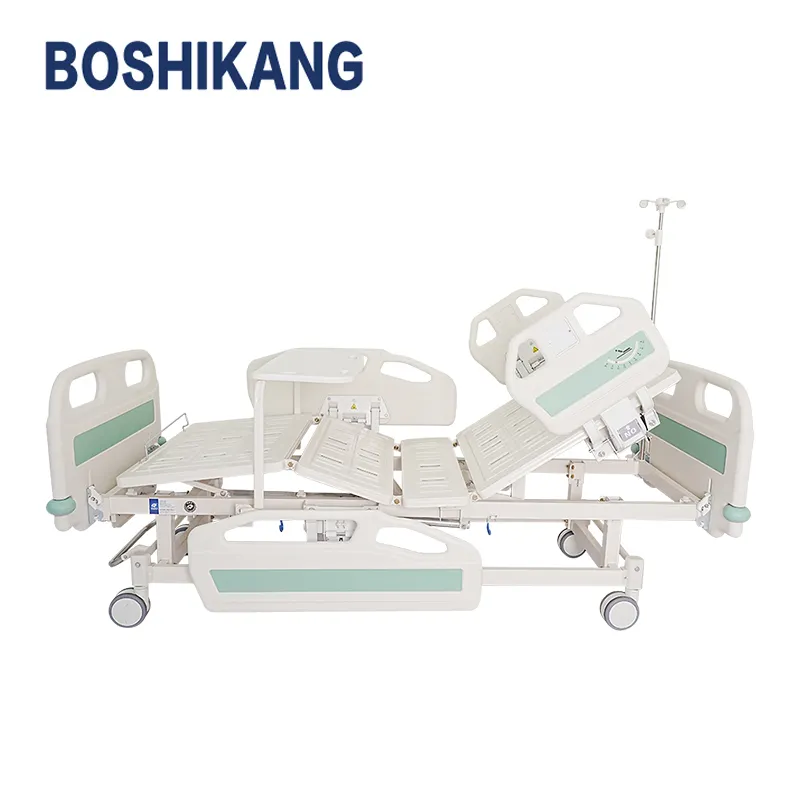บทบาทสำคัญของเตียงผู้ป่วยหนักในสถานการณ์ที่ต้องให้การดูแลเป็นเวลานาน
คุณสมบัติการออกแบบเฉพาะทางสำหรับการติดตามผลแบบต่อเนื่อง
เตียงไอซียูมีความจำเป็นอย่างยิ่งในการติดตามอาการผู้ป่วยตลอด 24 ชั่วโมง เนื่องจากมีคุณสมบัติพิเศษในตัวที่ออกแบบมาโดยเฉพาะ เตียงทันสมัยส่วนใหญ่ เตียง ICU มาพร้อมกับเครื่องตรวจจับที่ติดตั้งอยู่ภายในที่นอน ซึ่งสามารถตรวจสอบอัตราการเต้นของหัวใจ การหายใจ และสัญญาณชีพสำคัญอื่นๆ รวมถึงระบบแจ้งเตือนที่จะส่งสัญญาณไปยังพยาบาลเมื่อมีการเปลี่ยนแปลงใดๆ ทำให้แพทย์และพยาบาลสามารถเข้าช่วยเหลือได้อย่างรวดเร็วทันทีที่เกิดปัญหา ซึ่งส่งผลอย่างมากต่อการฟื้นตัวของผู้ป่วย รูปแบบการออกแบบเตียงเหล่านี้ทำให้เจ้าหน้าที่ทางการแพทย์สามารถเข้าถึงทุกส่วนของเตียงได้อย่างสะดวก โดยไม่รบกวนผู้ป่วยมากเกินไป จึงสามารถตรวจสอบสภาพผู้ป่วยได้เป็นประจำ ขณะเดียวกันก็รักษาความปลอดภัยให้กับทุกคน การศึกษาวิจัยจากโรงพยาบาลทั่วประเทศแสดงให้เห็นว่าการตรวจติดตามอย่างต่อเนื่องนั้นสามารถช่วยชีวิตผู้ป่วยได้จริง โดยเฉพาะเมื่อสามารถตรวจพบปัญหาแต่เนิ่นๆ ก่อนที่จะกลายเป็นภาวะฉุกเฉิน นี่จึงเป็นเหตุผลที่โรงพยาบาลลงทุนสูงในการจัดหาเตียงไฮเทคเหล่านี้สำหรับผู้ป่วยที่ต้องการการดูแลเป็นพิเศษในช่วงระยะเวลานาน
ระบบกระจายแรงกดสำหรับผู้ป่วยที่ต้องนอนบนเตียงตลอดเวลา
เตียงผู้ป่วยหนักในปัจจุบันมาพร้อมกับระบบการกระจายแรงดันที่ซับซ้อน ซึ่งช่วยป้องกันแผลกดทับที่พบบ่อยและเจ็บปวดในผู้ป่วยที่นอนติดเตียง รุ่นใหม่ล่าสุดมีคุณสมบัติเช่น แผ่นพื้นที่นอนปรับระดับได้และพื้นผิวที่สามารถเปลี่ยนการกระจายแรงกดบนส่วนต่าง ๆ ของร่างกายอย่างกระตือือรือร้น การวิจัยแสดงให้เห็นว่า การจัดการแรงกดที่ดีสามารถลดจำนวนผู้ป่วยที่เป็นแผลกดทับได้อย่างมีนัยสำคัญ ซึ่งส่งผลดีต่อผู้ป่วยที่ต้องอยู่ในห้องผู้ป่วยหนักเป็นเวลานานหลายสัปดาห์หรือหลายเดือน นอกจากการเพิ่มความสบายให้กับผู้ป่วยแล้ว การพัฒนาทางเทคโนโลยีเหล่านี้ยังมีส่วนช่วยเร่งระยะเวลาการฟื้นตัวอีกด้วย โรงพยาบาลที่ลงทุนในเตียง ICU ที่ดีกว่า ไม่ได้แค่ซื้ออุปกรณ์เท่านั้น แต่ยังเป็นการลงทุนในสิ่งที่มีผลโดยตรงต่อผลลัพธ์ของผู้ป่วยและลดภาวะแทรกซ้อนระหว่างการพักรักษาตัวในโรงพยาบาล
ICU Beds vs. Standard Hospital Beds: Key Functional Differences
การปรับระดับขั้นสูงเพื่อการจัดท่าทางรักษา
คุณสมบัติที่สามารถปรับเปลี่ยนได้ของเตียง ICU มีบทบาทสำคัญในเรื่องการจัดท่าทางเพื่อการบำบัด ซึ่งช่วยให้ผู้ป่วยรู้สึกสบายมากขึ้นในระหว่างกระบวนการฟื้นตัว เตียงโรงพยาบาลทั่วไปไม่มีตัวเลือกในการปรับได้หลากหลายเท่ากับเตียง ICU ที่ให้ผู้ดูแลสามารถปรับความสูง มุมเอียง และการเอียงของเตียงให้เหมาะสมกับความต้องการของผู้ป่วยแต่ละรายตามสภาพร่างกาย การปรับเตียงเหล่านี้ให้เหมาะสมสามารถสร้างความแตกต่างอย่างแท้จริงต่อการทำงานของระบบการหายใจ และช่วยลดภาวะแทรกซ้อนในผู้ป่วยที่มีอาการวิกฤต งานวิจัยหลายชิ้นแสดงให้เห็นว่า เมื่อแพทย์สามารถจัดท่าทางผู้ป่วยได้อย่างเหมาะสมโดยใช้เตียงที่ปรับระดับได้ จะนำไปสู่ผลลัพธ์ที่ดีขึ้นโดยรวมในหน่วยดูแลผู้ป่วยหนักทั่วประเทศ
กลไกควบคุมการติดเชื้อแบบติดตั้งภายใน
เตียง ICU มีสิ่งพิเศษสําหรับควบคุมโรค เช่น การเคลือบด้วยยาต้านเชื้อ และผิวที่สะอาดเร็ว เพื่อลดความเสี่ยงของการแพร่ระบาดของโรค เรื่องนี้สําคัญมากในห้องบํารุงรักษาเข้มข้น เพราะผู้ป่วยหลายคนในห้องนั้น มีระบบภูมิคุ้มกันที่อ่อนแอจากโรคร้ายแรง หรือการผ่าตัดเมื่อเร็วๆ นี้ โรงพยาบาลที่เปลี่ยนระบบควบคุมโรคที่ดีขึ้นเหล่านี้ ได้เห็นว่าจํานวนผู้ป่วยที่ติดเชื้อลดลงอย่างแท้จริง ซึ่งแสดงให้เห็นว่า การเปลี่ยนแปลงการออกแบบเหล่านี้ มีคุณค่าแค่ไหนต่อผลการรักษาของผู้ป่วย สิ่งที่ทําให้เตียง ICU แตกต่างจากเตียงโรงพยาบาลทั่วไป คือความเน้นอย่างมากในการหยุดการติดเชื้อที่เกิดขึ้นระหว่างการรักษา สําหรับสถานที่ที่ต้องการรักษามาตรฐานความสะอาดสูง การลงทุนในแบบ ICU ที่ทันสมัยเหล่านี้ มีเหตุผล แม้จะใช้จ่ายสูงกว่า
วิธีที่เตียง ICU สนับสนุนการจัดการโรคประจำตัว
การผสานระบบช่วยการหายใจสำหรับผู้ป่วยที่ต้องใช้เครื่องช่วยหายใจ
ปัจจุบันเตียงผู้ป่วยหนัก (ICU) หลายแบบมีระบบช่วยการหายใจในตัวซึ่งมีความสำคัญอย่างมากในการดูแลผู้ป่วยที่ต้องพึ่งเครื่องช่วยหายใจ ระบบเหล่านี้ช่วยให้การจัดการทางเดินหายใจเป็นไปอย่างเหมาะสม และช่วยให้บุคลากรทางการแพทย์สามารถปรับค่าต่าง ๆ ของการระบายอากาศได้โดยตรงที่เตียงผู้ป่วย โดยไม่จำเป็นต้องเคลื่อนย้ายผู้ป่วย การรักษาความเสถียรและความสบายของผู้ป่วยจึงทำได้ง่ายขึ้นมาก โดยเฉพาะในช่วงเวลาที่เข้มข้นของการดูแลผู้ป่วยหนัก เมื่อโรงพยาบาลสามารถจัดการการสนับสนุนการหายใจจากตัวเตียง ICU ได้อย่างมีประสิทธิภาพ ก็มักจะเห็นผลลัพธ์ที่ดีขึ้นโดยรวม ผู้ป่วยมักใช้เวลาในการต่อเครื่องช่วยหายใจน้อยลง ซึ่งหมายถึงการฟื้นตัวที่รวดเร็วขึ้น และมีภาวะแทรกซ้อนน้อยลงในระยะยาว
การป้องกันอาการชักด้วยคุณสมบัติจำกัดการเคลื่อนไหว
เตียงผู้ป่วยหนักถูกออกแบบมาเพื่อช่วยรักษาความปลอดภัยของผู้ป่วยด้วยองค์ประกอบพิเศษที่จำกัดการเคลื่อนไหว เพื่อป้องกันการเกิดชัก โดยส่วนใหญ่แล้วแบบเตียงจะมีราวจับด้านข้าง และบางครั้งมีสายรัดเพื่อตรึงตัวผู้ป่วยไว้ ซึ่งเจ้าหน้าที่จะนำมาใช้เมื่อจำเป็นสำหรับผู้ป่วยที่เป็นโรคลมชักหรือภาวะคล้ายคลึงกัน ระบบความปลอดภัยเหล่านี้ช่วยลดการบาดเจ็บในช่วงเวลาสำคัญที่ผู้ป่วยอาจเกิดอาการชักแบบไม่คาดคิด โรงพยาบาลที่ให้ความสำคัญกับการป้องกันอาการชักอย่างมีประสิทธิภาพ จะพบว่าผู้ป่วยกลุ่มที่มีความเปราะบางมีอุบัติเหตุลดลงระหว่างที่พักรักษาตัวอยู่ในสถานพยาบาล นอกจากการป้องกันอาการชักแล้ว เตียงผู้ป่วยหนักยุคใหม่ยังมีอุปกรณ์ช่วยการหายใจรวมอยู่ด้วย พร้อมทั้งระบบควบคุมการเคลื่อนไหว ซึ่งจริงๆ แล้วถือเป็นสิ่งจำเป็นมากในการจัดการกับปัญหาสุขภาพระยะยาวอย่างเหมาะสม ช่วยให้ทั้งปกป้องผู้ป่วยและเพิ่มทางเลือกในการรักษาโดยรวมที่ดีขึ้นสำหรับผู้ที่ต้องการการดูแลอย่างเข้มข้น
ความก้าวหน้าทางเทคโนโลยีในระบบเตียง ICU ยุคใหม่
เซ็นเซอร์อัจฉริยะสำหรับการวิเคราะห์สุขภาพเชิงพยากรณ์
เตียงผู้ป่วยหนัก (ICU) กำลังกลายเป็นอุปกรณ์อัจฉริยะมากขึ้นอย่างรวดเร็ว โดยเฉพาะในขณะนี้ที่โรงพยาบาลต่าง ๆ กำลังเพิ่มเซ็นเซอร์หลากหลายชนิดเข้ามา เพื่อทำนายปัญหาสุขภาพก่อนที่มันจะเกิดขึ้นจริง เซ็นเซอร์เหล่านี้จะรวบรวมข้อมูลแบบเรียลไทม์ ซึ่งแพทย์และพยาบาลสามารถนำไปใช้ประโยชน์ได้จริงในการตรวจพบปัญหาแต่เนิ่น ๆ และดำเนินการก่อนที่สถานการณ์จะแย่ลง ซึ่งย่อมส่งผลให้ผู้ป่วยรู้สึกดีขึ้นตลอดช่วงเวลาที่พักรักษาตัวในโรงพยาบาล งานวิจัยจากหลายโรงพยาบาลแสดงให้เห็นว่า สถานที่ที่นำเทคโนโลยีนี้มาใช้ มีผลลัพธ์เชิงลบลดลง และการจัดการผู้ป่วยที่เจ็บป่วยหนักมีประสิทธิภาพดีขึ้นโดยรวม เมื่ออุปกรณ์ขนาดเล็กเหล่านี้คอยติดตามอัตราการเต้นของหัวใจ รูปแบบการหายใจ และตัวเลขสำคัญอื่น ๆ ตลอดเวลา พนักงานสามารถเข้าไปจัดการได้รวดเร็วขึ้นเมื่อสังเกตเห็นสิ่งผิดปกติ ช่วยให้ผู้ป่วยมีความปลอดภัยมากขึ้น และรับประกันว่าการรักษาจะให้ผลสำเร็จตามที่คาดหวังไว้เป็นส่วนใหญ่
โปรโตคอลการพลิกตัวผู้ป่วยโดยอัตโนมัติ
เตียงผู้ป่วยหนัก (ICU) ในปัจจุบันได้รับการอัปเกรดเทคโนโลยีที่น่าทึ่งไปอีกระดับ หนึ่งในนั้นคือระบบการพลิกตัวผู้ป่วยอัตโนมัติ ซึ่งช่วยได้มากในการป้องกันแผลกดทับที่เกิดขึ้นได้ง่าย เครื่องเหล่านี้ทำงานร่วมกับอุปกรณ์ตรวจสอบต่าง ๆ เพื่อปรับเปลี่ยนท่าทางของผู้ป่วยตามความจำเป็น โดยพิจารณาจากสภาพของผู้ป่วยแต่ละราย ซึ่งหมายความว่าผู้ป่วยจะรู้สึกสบายมากขึ้น และยังช่วยให้เจ้าหน้าที่พยาบาลทำงานได้ง่ายขึ้นด้วย โรงพยาบาลหลายแห่งรายงานว่าปัญหาเรื่องผิวหนังลดลงนับตั้งแต่ใช้งานระบบเหล่านี้ และยังช่วยประหยัดค่าใช้จ่ายในระยะยาว เพราะผู้ป่วยฟื้นตัวได้เร็วขึ้นโดยไม่มีภาวะแทรกซ้อน ถ้ามองในแง่ของประโยชน์ใช้สอย การพลิกตัวผู้ป่วยอัตโนมัติช่วยแก้ปัญหาใหญ่ในโรงพยาบาล ซึ่งก็คือการบาดเจ็บจากแรงกดที่ทำให้ผู้ป่วยทุกข์ทรมานและเพิ่มค่าใช้จ่ายทางการแพทย์
ความท้าทายในการใช้งานเตียง ICU เป็นเวลานาน
กลยุทธ์การป้องกันการฝ่อของกล้ามเนื้อ
การพักรักษาตัวเป็นเวลานานในห้องผู้ป่วยหนัก (ICU) มักมาพร้อมกับปัญหาร้ายแรงอย่างการลีบของกล้ามเนื้อ ซึ่งหมายความว่าโรงพยาบาลต้องคำนึงถึงการออกแบบเตียงที่สามารถช่วยป้องกันปัญหานี้ได้ วิธีการที่ค่อนข้างชาญฉลาดได้ถูกพัฒนาขึ้นมาไม่นานมานี้เพื่อต่อสู้กับการเสื่อมสภาพของกล้ามเนื้อ ตัวอย่างเช่น การบำบัดด้วยการเคลื่อนไหวแบบพาสซีฟ (Passive Movement Therapy) โดยพยาบาลจะเคลื่อนไหวแขนขาของผู้ป่วยอย่างเบามือ รวมถึงอุปกรณ์ที่ส่งสัญญาณไฟฟ้าขนาดเล็กเพื่อกระตุ้นให้กล้ามเนื้อทำงาน แม้ในกรณีที่ผู้ป่วยไม่สามารถขยับตัวเองได้ งานวิจัยหลายชิ้นสนับสนุนประสิทธิภาพของเทคนิคเหล่านี้แม้ว่าผลลัพธ์อาจแตกต่างกันไปตามแต่ละสถานพยาบาล เมื่อโรงพยาบาลนำฟีเจอร์เหล่านี้มาใช้งานจริงในเตียงผู้ป่วย มักพบว่าผู้ป่วยสูญเสียมวลกล้ามเนื้อในระหว่างการฟื้นตัวน้อยลง การรักษากล้ามเนื้อให้อยู่ในสภาพดีนั้นมีความสำคัญอย่างมากในระยะยาว ทั้งในแง่ของการฟื้นตัวที่รวดเร็วขึ้น และการป้องกันปัญหาสุขภาพที่ร้ายแรงมากยิ่งขึ้นในอนาคต
ผลกระทบทางจิตวิทยาจากการพักรักษาตัวในห้องผู้ป่วยหนักเป็นเวลานาน
การพักรักษาตัวเป็นเวลานานในห้องผู้ป่วยหนักมักนำมาซึ่งปัญหาด้านจิตใจ เช่น อาการสับสนทางจิต (delirium) และภาวะซึมเศร้า ซึ่งหมายความว่า แพทย์จำเป็นต้องคิดถึงปัจจัยอื่นๆ นอกเหนือจากการรักษาทางการแพทย์เพียงอย่างเดียว ในการดูแลผู้ป่วย ในช่วงไม่กี่ปีที่ผ่านมา เตียงผู้ป่วยในห้อง ICU มีการพัฒนาให้มีคุณสมบัติที่ช่วยให้ผู้ป่วยรู้สึกมีส่วนร่วมและสบายมากยิ่งขึ้น เช่น ไฟปรับระดับได้ หรือแม้แต่ตัวเลือกสำหรับความบันเทิงที่ถูกออกแบบมาให้ใช้งานได้ในตัว เบื้องต้น การวิจัยแสดงให้เห็นว่า การดูแลสภาพจิตใจของผู้ป่วยมีความสำคัญอย่างมากในช่วงที่อยู่ในห้อง ICU โดยสภาพแวดล้อมที่ดีสามารถช่วยให้ผู้ป่วยฟื้นตัวได้เร็วยิ่งขึ้น และรู้สึกพึงพอใจกับประสบการณ์การรักษาในโรงพยาบาลมากขึ้น เมื่อผู้ผลิตเริ่มเพิ่มคุณสมบัติที่ช่วยส่งเสริมสุขภาพจิตเข้าไปในเตียงผู้ป่วย พวกเขาไม่ได้เพียงแค่ดูแลเฉพาะด้านร่างกายเท่านั้น แต่กำลังสร้างสภาพแวดล้อมที่ทั้งร่างกายและจิตใจสามารถฟื้นฟูไปพร้อมกันได้ ทำให้การเข้าพักรักษาตัวในโรงพยาบาลเป็นประสบการณ์ที่ลดความรุนแรงทางจิตใจลงสำหรับทุกฝ่ายที่เกี่ยวข้อง

แนวโน้มการออกแบบเตียง ICU เพื่อการดูแลระยะยาวในอนาคต
ระบบทำนายแผลกดทับแบบใช้ปัญญาประดิษฐ์
การติดตั้งระบบแจ้งเตือนแผลกดทับที่ใช้ปัญญาประดิษฐ์ (AI) ลงในเตียงผู้ป่วยหนัก (ICU) กำลังเปลี่ยนวิธีที่โรงพยาบาลจัดการเรื่องการปกป้องผิวหนัง ระบบที่ชาญฉลาดเหล่านี้ทำงานด้วยสูตรคณิตศาสตร์ที่ซับซ้อน ซึ่งจะพิจารณาข้อมูลของผู้ป่วยหลากหลายประเภท เพื่อทำนายว่าเมื่อใดที่ผู้ป่วยอาจเกิดแผลกดทับจากนอนนิ่งเป็นเวลานาน ระบบจะตรวจสอบสิ่งต่างๆ เช่น ระดับการเคลื่อนไหวของร่างกาย และจุดที่น้ำหนักของผู้ป่วยกดลงบนที่นอนมากที่สุด พยาบาลจึงสามารถเข้าไปแทรกแซงได้ตั้งแต่เนิ่นๆ ก่อนที่จะเกิดความเสียหายจริง โรงพยาบาลที่เริ่มใช้เทคโนโลยีนี้รายงานว่ามีผู้ป่วยที่เกิดแผลกดทับลดลง ซึ่งหมายความว่าผู้ป่วยฟื้นตัวได้เร็วขึ้น และเจ้าหน้าที่มีงานลดลงจากการรักษาปัญหาที่สามารถป้องกันได้ บางแห่งยังระบุว่าสามารถประหยัดค่าใช้จ่ายในเรื่องผ้าพันแผลพิเศษและชั่วโมงการทำงานเพิ่มเติมของพยาบาล เนื่องจากการป้องกันทำงานได้ดีกว่าการรักษา
การออกแบบที่แยกชิ้นส่วนสำหรับการดูแลผู้ป่วยระยะวิกฤตที่บ้าน
เตียง ICU แบบโมดูลาร์กำลังได้รับความนิยมมากขึ้นเรื่อยๆ เนื่องจากมีผู้ป่วยที่ต้องการการดูแลทางการแพทย์อย่างเข้มข้นเพิ่มขึ้น หน้าแรก แทนที่จะเป็นโรงพยาบาล เตียงเหล่านี้ไม่ใช่เตียงโรงพยาบาลมาตรฐานทั่วไป แต่สามารถขยายหรือปรับเปลี่ยนได้ตามความต้องการที่แท้จริงของผู้ป่วยแต่ละราย ซึ่งหมายความว่าการดูแลรักษาสามารถทำได้ดีแม้แต่ในห้องนั่งเล่นของตนเอง ตัวอย่างเช่น บางโมดูลอาจมีระบบตรวจสอบติดตั้งไว้ภายใน ในขณะที่บางโมดูลมีตัวช่วยพิเศษสำหรับผู้ป่วยที่มีปัญหาในการเคลื่อนไหว ผู้ดูแลรักสิ่งนี้เพราะสามารถปรับทุกอย่างตั้งแต่ความสูงไปจนถึงจุดความดัน ขึ้นอยู่กับสถานการณ์ งานวิจัยแสดงให้เห็นว่าผู้ป่วยมักจะฟื้นตัวได้เร็วขึ้นเมื่อใช้ระบบที่ปรับเปลี่ยนได้แบบนี้ เมื่อเทียบกับอุปกรณ์แบบดั้งเดิม เมื่อโรคเรื้อรังพบได้ทั่วไปมากขึ้น ผู้ผลิตจึงพัฒนาคุณสมบัติใหม่ๆ ออกมาอย่างต่อเนื่อง เพื่อทำให้การดูแลสุขภาพที่บ้านปลอดภัยและมีประสิทธิภาพมากยิ่งขึ้นตามกาลเวลา
วิวัฒนาการในการออกแบบเตียง ICU สะท้อนให้เห็นถึงความมุ่งมั่นในการปรับปรุงคุณภาพชีวิตของผู้ป่วยผ่านนวัตกรรมเทคโนโลยีและการออกแบบที่ก้าวหน้า จากระบบขับเคลื่อนด้วย AI ไปจนถึงรูปแบบโมดูลาร์ ความก้าวหน้าเหล่านี้นำเสนอแนวทางแก้ไขที่มีศักยภาพสำหรับความท้าทายที่เผชิญในสภาพแวดล้อมการดูแลผู้ป่วยเรื้อรัง
ส่วน FAQ
อะไรที่ทำให้เตียง ICU แตกต่างจากเตียงโรงพยาบาลมาตรฐาน
เตียง ICU มีความยืดหยุ่นสูง พร้อมติดตั้งระบบควบคุมการติดเชื้อ และมีระบบที่ออกแบบมาเฉพาะสำหรับสถานการณ์การดูแลผู้ป่วยหนัก ซึ่งแตกต่างจากเตียงโรงพยาบาลทั่วไป
เหตุใดระบบกระจายแรงกดจึงมีความสำคัญในเตียง ICU?
ระบบนี้ช่วยลดความเสี่ยงของแผลกดทับ โดยการกระจายแรงกดออกจากบริเวณที่เปราะบาง เพื่อเพิ่มความสบายและเร่งการฟื้นตัวของผู้ป่วย
เตียง ICU สนับสนุนผู้ป่วยที่ต้องใช้เครื่องช่วยหายใจอย่างไร?
เตียง ICU มักติดตั้งระบบช่วยระบบทางเดินหายใจไว้ล่วงหน้า ซึ่งสามารถปรับการระบายอากาศได้อย่างราบรื่นโดยไม่จำเป็นต้องเคลื่อนย้ายผู้ป่วย
มีความก้าวหน้าทางเทคโนโลยีใดบ้างในระบบเตียง ICU รุ่นใหม่?
คุณสมบัติขั้นสูงรวมถึงเซ็นเซอร์อัจฉริยะสำหรับการวิเคราะห์สุขภาพเชิงทำนาย และโปรโตคอลการพลิกตัวผู้ป่วยแบบอัตโนมัติเพื่อมาตรฐานการดูแลที่ดีขึ้น
การออกแบบเตียง ICU แบบโมดูลาร์สำหรับการดูแลที่บ้านมีข้อดีอย่างไร?
การออกแบบแบบโมดูลาร์ให้ความยืดหยุ่นและการขยายตัวได้ ช่วยให้ปรับแต่งตามความต้องการของผู้ป่วย เพื่อเพิ่มคุณภาพในการดูแลผู้ป่วยหนักที่บ้าน
สารบัญ
- บทบาทสำคัญของเตียงผู้ป่วยหนักในสถานการณ์ที่ต้องให้การดูแลเป็นเวลานาน
- ICU Beds vs. Standard Hospital Beds: Key Functional Differences
- วิธีที่เตียง ICU สนับสนุนการจัดการโรคประจำตัว
- ความก้าวหน้าทางเทคโนโลยีในระบบเตียง ICU ยุคใหม่
- ความท้าทายในการใช้งานเตียง ICU เป็นเวลานาน
- แนวโน้มการออกแบบเตียง ICU เพื่อการดูแลระยะยาวในอนาคต
- ส่วน FAQ


